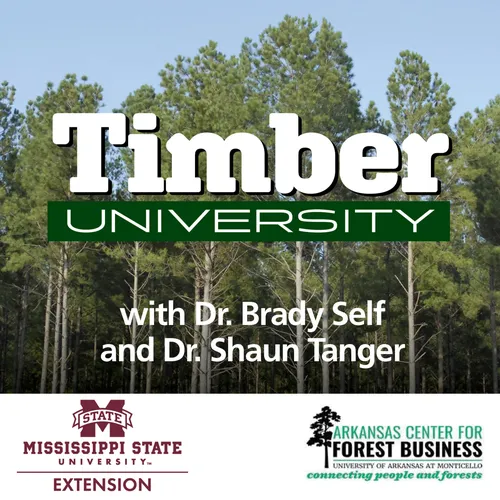
Timber University
Timber University is a science-based podcast covering the latest research in timber management.
Part of the Natural Resources University podcast network.
- Update frequency
- every 28 days
- Average duration
- 41 minutes
- Episodes
- 34
- Years Active
- 2022 - 2025

Forest Health Happenings in the US South | 35
In this episode, we are joined by Dr. Kristy McAndrew from Mississippi State University. Dr. McAndrew will walk us through the ins and outs of Brown spot needle blight, a fungal disease that infects …

Q and A episode| Ep 34
In this episode, we return to the mailbag to answer listener questions. Brady covers the current status of brownspot needle blight and thinning pines with herbicide applications as an alternative to …

Thinning for Wildlife Objectives | Ep 33
In this episode, Dr. Tanger and Dr. Self are joined by Dr. Bronson Strickland as they consider how wildlife objectives can influence thinning regimes in forest management. Dr. Bronson Strickland, th…

Longleaf Pine Management Considerations | Ep 32
Silvicultural methodology for longleaf pine is sometimes misunderstood by landowners and land managers. Join the Timber University team as they discuss longleaf systems and their management using c…

Timber Market Outlook | Ep 31
Today we discuss what's happening in the US south timber markets. We cover what drives lumber consumption, what to keep an eye on for housing, and discuss stumpage drivers and price expectations.
For…

Pine Thinning Part 2 - Alternatives | Ep 30
Today's episode, we explore what strategies landowners and managers can utilized when standard thinning operations cannot occur due to poor markets. For questions or comments, email us at timberunive…

Pine Thinning | Ep 29
In today's episode, we go back to basics and map out for listeners the biological, operational, and economic considerations of thinning pine stands. For most in the southeast, markets are tough for p…

Q&A Episode | Ep 28
In this episode we take a shot at listener questions, ranging from controlling tree of heaven to addressing the pros and cons of managing for longleaf as compared to loblolly pine. We also address on…

The Loper Decision and How it May Affect Forest Landowners | Ep 27
In this episode we speak with Dr. Kevin Boston from the University of Arkansas at Monticello to discuss a recent landmark Supreme Court decision Loper Bright Enterprises v. Raimondo (2024) that overt…

Carbon Markets | Ep 26
In this episode we circle back to carbon markets with a very special guest Dr. Gregory Latta, Associate Research Professor of Forest Economics and Director of Policy Analysis Group at the University …

Intermediate herbicide treatments for forest management in the South | Ep 25
Most people interested in management of forests are familiar with chemical site preparation as a management tool. However, many are not aware of other herbicide application options available for fine…

Forest Carbon | Ep 24
Today, we are joined by a special guest Alicia Robbins, who is Vice President of Portfolio Analytics and Business Development with Weyerhaeuser. She discusses the basics of forestry carbon and the fl…

Introduction to Estate Planning | Ep 23
Approximately two thirds of Americans do not have a will and the implications of this can be far reaching. Join us as Dr. Rebecca Smith, Director of the Mississippi State University Extension Center …

Forest Management and Prescribed Burning | Ep 22
Join Timber University and special guest John Gruchy, a Wildlife Biologist with the Mississippi Department of Wildlife, Fisheries and Parks. John is the Coordinator of the Private Lands Program, incl…

Fire Ecology and History in the South | Ep 21
This episode we are joined by Dr. Morgan Varner from the Tall Timbers Land Trust and Research Center. Dr. Varner discusses the benefits of fire on the landscape, a brief history of utilizing prescrib…

Status of Needle Blight in the South | Ep 20
Over the past few years, brownspot needle blight and an assemblage of other problematic pathogenic species have garnered increasing concern in pine systems across the South. Join us as we discuss the…

Pine Beetles and Forest Management Concerns | Ep 19
Pine beetle outbreaks are usually not the result of one stress factor, but the cumulative result of several possible variables that lower pine vigor. Join us, along with Dr. John Riggins, Mississippi…

Listener Questions | Ep 18
This month is the first Q&A episode. Brady and Shaun get to listener questions they have received since the first episode. They discuss taxes, some hardwood silviculture, and the northern long-eared …

Natural Regeneration of Pines | Ep 17
Prior to active silvicultural management, natural regeneration propagated pine species across the South for millennia. Join the Timber University team and their guest, Dr. Michael Blazier with the Un…

Artificial Pine Regeneration | Ep 16
Pine regeneration efforts often deviate from work in hardwoods due to genetic advances we have made in available planting stock choices. For this reason, artificial regeneration is typically chosen b…